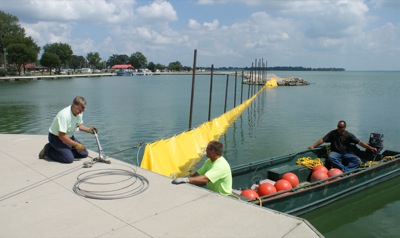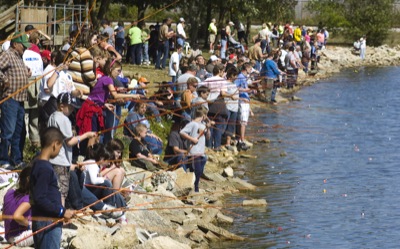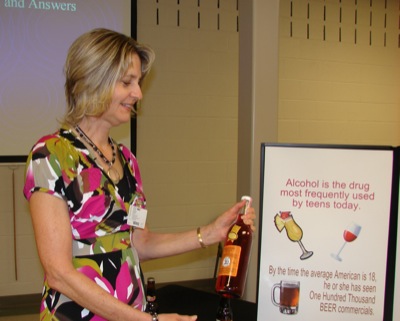Thursday, September 16th, 2010
Early study: alum won't work
Experts now say success possible in Grand Lake
By Shelley Grieshop

Photo by Shelley Grieshop/The Daily Standard
Celina city workers are shown several weeks ago working near the Celina Rotary lighthouse on a pilot project involving silica. Water quality experts hope the silica - and another test project to begin next week involving the use of aluminum sulfate - will reduce the blue-green algae problem in Grand Lake.
GRAND LAKE - A recent recommendation to use aluminum sulfate (alum) to fight Grand Lake's blue-green algae problem was nixed 30 years ago by environmental experts.
A report released in 1981 by the U.S. Army Corps of Engineers to address water quality issues says alum treatment is "inappropriate" and its success "doubtful" at Grand Lake, mainly because it's too shallow.
However, a spokeswoman for the Ohio EPA said the study is outdated and today's technology makes alum a good bet for the lake.
"It is important to note that science has greatly advanced in the 30 years since the research was done for that report," Dina Pierce said.
A liquid alum application is one of the treatments recently proposed by the EPA to help eradicate the toxic blue-green algae blooms that critically plagued the lake and local economy this summer. Trial applications are planned next week at six lakeshore locations across 53 acres. If successful, a lake-wide application may occur next spring.
The cost of the pilot project is being funded by a $250,000 Ohio EPA grant through the Ohio Department of Natural Resources.
Another test project, silica (sand) treatment, is underway along Lake Shore Drive in Celina.
Alum is commonly used to decrease phosphorus, which feeds the nuisance algae. Experts say liquid alum should bind the phosphorus in the water and carry it to the bottom of the lake.
The '81 report said turbidity and wave action in Grand Lake would prevent the phosphorus and alum mixture (floc) from settling. Today's experts agree with that fact, but call it good news, not bad.
"The occasional disturbance of the floc has actually been found to be helpful," Pierce said. "As the floc is disturbed ... it becomes suspended and re-suspended in the water column multiple times. Each time that happens, alum is exposed to phosphorus in the water again and continues to bind it until the alum's receptors are used up."
The earlier study also said the long-term impact of alum on fish and wildlife is "unpredictable" due to a rise in pH levels. However, Pierce said buffering agents - which weren't used in the past - are now utilized to maintain safe pH levels.
The '81 report concluded with numerous recommendations to the state, such as dredging the lake and promotion of better agricultural practices, but all were "encouraged," not mandated.
Representatives with the Ohio Department of Natural Resources - which is responsible for the lake - did not respond to an inquiry by the newspaper concerning their actions to these water quality recommendations.
Other studies such as one completed in 1999 by the University of Minnesota also noted that shallow lakes with blue-green algae problems don't respond well to alum treatments. The report also stated that external loading - the amount of phosphorus coming into the lake - must be addressed before chemical treatments are applied.
Pierce disagreed.
"We strongly believe it is critical to first inactivate the current high levels of phosphorus within the lake while at the same time implementing various land use changes and improved management practices to reduce the external nutrient inputs," she said.
Even if phosphorus no longer entered the lake, the existing amounts in the sediment could feed harmful algae blooms for many years, she added.
Eighty percent of the 59,000-acre Grand Lake watershed is farmland. Phosphorus in the manure runs off the land and into the lake. The state in July announced the implementation of new manure management rules for the watershed effective in 2012.
Pierce admits there is uncertainty about how the alum will perform in Grand Lake and how long any success would last. It's never been tested in a lake of this size, she added.
"Grand Lake St. Marys is unique. It would be the largest lake alum treatment has been attempted on," she said. "That is why we are starting with several test areas."
The alum test project will be deemed successful if phosphorus levels are reduced 60 to 85 percent and remain at these levels for at least 28 days, the EPA said.
"Long term, we know that alum treatment has been done to about 150 lakes in the U.S. and about 300 worldwide over the past 50 years and it has proven successful," Pierce said.
Mercer County Economic and Community Development Director Jared Ebbing is skeptical about the alum project. He calls it a temporary "Band-Aid to stop the bleeding."
"It's probably not long term, but it takes us out of this crisis mode we're in," he said.
Ebbing said the lake is out of balance and "we have to act fast." Lake-area businesses that thrive on tourism have lost an average of 30 percent of their revenue this year. Most are blaming the lake, he said.
The alum treatment could serve as an indirect revenue boost for businesses, he said.
"If it's successful, it could help some of them get back on their feet again," he said.
Alum project:
The aluminum sulfate (alum) test project is scheduled to begin next week at six sites totaling nearly 53 acres of Grand Lake. A barge will distribute the liquid alum.
It is hoped that the alum will cause the phosphorous in the water to bind and drop to the bottom, making it unavailable for blue-green algae to use as a food source. If the chemical is successful, a lake-wide application likely will occur next spring, according to Ohio EPA.
The test areas of application include: West Beach (8.11 acres), Harmon's channel (13.1 acres), 4-H Camp (10.18 acres), West Bank boat ramp (8.75 acres), Otterbein channel No. 1 (7.55 acres) and Otterbein channel No. 2 (5.25 acres).
- Shelley Grieshop




